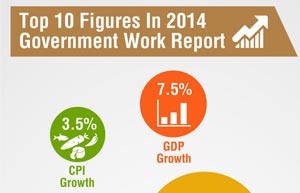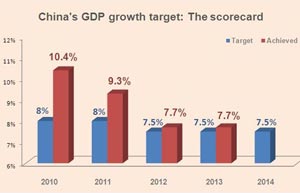Reform implementation gathers pace in 2014
This year's government report is heavy with reform proposals, as this is the first year of reform implementation following the 3rd Plenum. As expected, relatively easier reforms and those with the broadest consensus will be pushed forward faster in the near term, with examples including government administration, social safety net, ongoing tax and factor price reforms and financial sector reforms.
Easier reforms first.
In particular, the government plans to slash or decentralize another 200 administrative approvals in 2014, expand the basic pension coverage to more people in urban and rural areas, raise government contribution to rural health insurance system, expand serious disease coverage to more areas, expand the business-for VAT tax reform to railway, postal service, and telecom sectors, expand resource tax reforms to the coal sector, adjust consumption taxes, and adjust prices of natural gas, power and utilities.Financial sector reform as expected. This year's reforms will include establishing a deposit insurance system, continuing with China's interest rate liberalization, allowing the establishment of private banks, expanding the exchange rate trading band, reforming policy banks, and reforming the IPO system as well as developing the bond market. Establishing a deposit insurance system is widely considered as a pre-requisite of full deposit rate liberalization, so this could indicate a faster pace of rate liberalization ahead, as market circumstances perhaps warrant. Establishing a deposit insurance and crisis resolution mechanism will also lay the foundation for allowing more credit defaults and exit of small financial institutions. In response to recent debates on shadow banking and China's burgeoning Internet banking sector, the government talked about encouraging healthy development of Internet financing and coordinated financial supervision.
Fiscal and local government finance reforms may proceed more gradually. The focus of fiscal reform this year may be in the area of budgetary reform, with more spending items and revenue sources being brought into a more comprehensive and transparent budgeting system. The detailed tax reforms in the government report are very much an extension of on-going tax reforms and expected. The wording surrounding the much-feared property tax issue remains focused on "accelerating legislative process"; a similar wording is used on environment tax as well. While there has been a notable change on the government's attitude towards local government's increasing debt, the wording used suggests that progress will be gradual and start with pilots in some localities. Meanwhile, the central government will issue 400 billion yuan in local debt on their behalf, a 50 billion yuan increase relative to 2013 and not large enough to replace any existing debt owed to banks. Meanwhile, Private Public Participation (PPP) seems to have become the new buzz word for mitigating the financing pressures in public infrastructure and social housing projects.
"War on pollution". Acknowledging serious environmental issues, Premier Li has declared a "war on pollution". The government plans to work from the following aspects to control pollution and improve the environment:
- Retiring polluting capacities including 27 million tons of iron and steel capacity and six million cars that do not meet fuel and emission standards;
- Developing "new" energy and cleaning up coal-fired power plants, including installing dust-control equipment on 180 megawatts of power facilities in 2014;
- Increasing fuel standards by requiring all diesel to meet national-4 standard and upgrading refining capacities in the coming years;
- Tightening building standards including via an introduction of mandatory "green" standards for all public buildings and buildings larger than 20,000 square meters;
- Adjusting energy and utility prices including natural gas prices for industrial users, water prices, power prices, and raising resource tax on coal;
- Pushing forward with key river system pollution treatment and soil recovering projects.
More market opportunities in SOE reforms. At this stage, the government seems to be focusing on increasing private participation within SOE reforms, perhaps hoping that this will help increase private capital invested, as well as improve upon the efficiency of SOE activities. In 2014, the government plans to roll out investment projects in the sectors of finance, petroleum, power, railway, telecom, resource development and public utilities for private participation, including perhaps State assets divestment. The report also called for an increase in SOE dividend payment but gave no specifics, and a higher share of the existing dividend to the government will be used in public finance (such as social security) rather than to be ploughed back into SOEs (as is the current practice).
The author is Chief China Economist at UBS. This article is co-authored with UBS economists Donna Kwok, Harrison Hu and Ning Zhang.
The views do not necessarily represent those of China Daily.
|
 |
 |